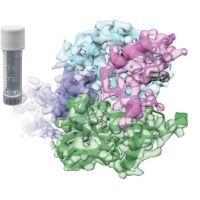Specification
| Description | Recombinant protein from the full-length sequence of Homo sapiens S100 calcium binding protein A1 (S100A1) (NM_006271). |
| Organism | Homo sapiens (Human) |
| Expression Host | Human Cells |
| Tag Info | His or DYKDDDDK. Please contact us if you need further information or require specific designed tag. |
| Purity | Greater than 90% by SDS-PAGE gel |
| Uniprot ID | P23297 |
| Entry Name | S10A1_HUMAN |
| Gene Names | S100A1 S100A |
| Alternative Gene Names | S100A |
| Alternative Protein Names | Protein S100-A1 (S-100 protein alpha chain) (S-100 protein subunit alpha) (S100 calcium-binding protein A1) |
| Application | Antigens, Western, ELISA and other in vitro binding or in vivo functional assays, and protein-protein interaction studies; For research & development use only! |
| Buffer | Purified protein formulated in a sterile solution of PBS buffer, pH7.2, without any preservatives |
| Endotoxin | Endotoxin level is < 0.1 ng/µg of protein (<1EU /µg) |
| Length | 94 |
| Molecular Weight(Da) | 10546 |
| Protein Sequence | (The sequence of expressed protein may have some variation from the sequence shown below. Please contact us for the exact sequence.) MGSELETAMETLINVFHAHSGKEGDKYKLSKKELKELLQTELSGFLDAQKDVDAVDKVMKELDENGDGEVDFQEYVVLVAALTVACNNFFWENS |
Background
| Function | FUNCTION: Small calcium binding protein that plays important roles in several biological processes such as Ca(2+) homeostasis, chondrocyte biology and cardiomyocyte regulation (PubMed:12804600). In response to an increase in intracellular Ca(2+) levels, binds calcium which triggers conformational changes (PubMed:23351007). These changes allow interactions with specific target proteins and modulate their activity (PubMed:22399290). Regulates a network in cardiomyocytes controlling sarcoplasmic reticulum Ca(2+) cycling and mitochondrial function through interaction with the ryanodine receptors RYR1 and RYR2, sarcoplasmic reticulum Ca(2+)-ATPase/ATP2A2 and mitochondrial F1-ATPase (PubMed:12804600). Facilitates diastolic Ca(2+) dissociation and myofilament mechanics in order to improve relaxation during diastole (PubMed:11717446). {ECO:0000269|PubMed:11717446, ECO:0000269|PubMed:12804600, ECO:0000269|PubMed:22399290, ECO:0000269|PubMed:23351007}. |
| Pathway | |
| Protein Families | S-100 family |
| Tissue Specificity | Highly prevalent in heart (PubMed:12804600, PubMed:1384693). Also found in lesser quantities in skeletal muscle and brain (PubMed:1384693). {ECO:0000269|PubMed:12804600, ECO:0000269|PubMed:1384693}. |
QC Data
| Note | Please contact us for QC Data |
| Product Image (Reference Only) |  |

